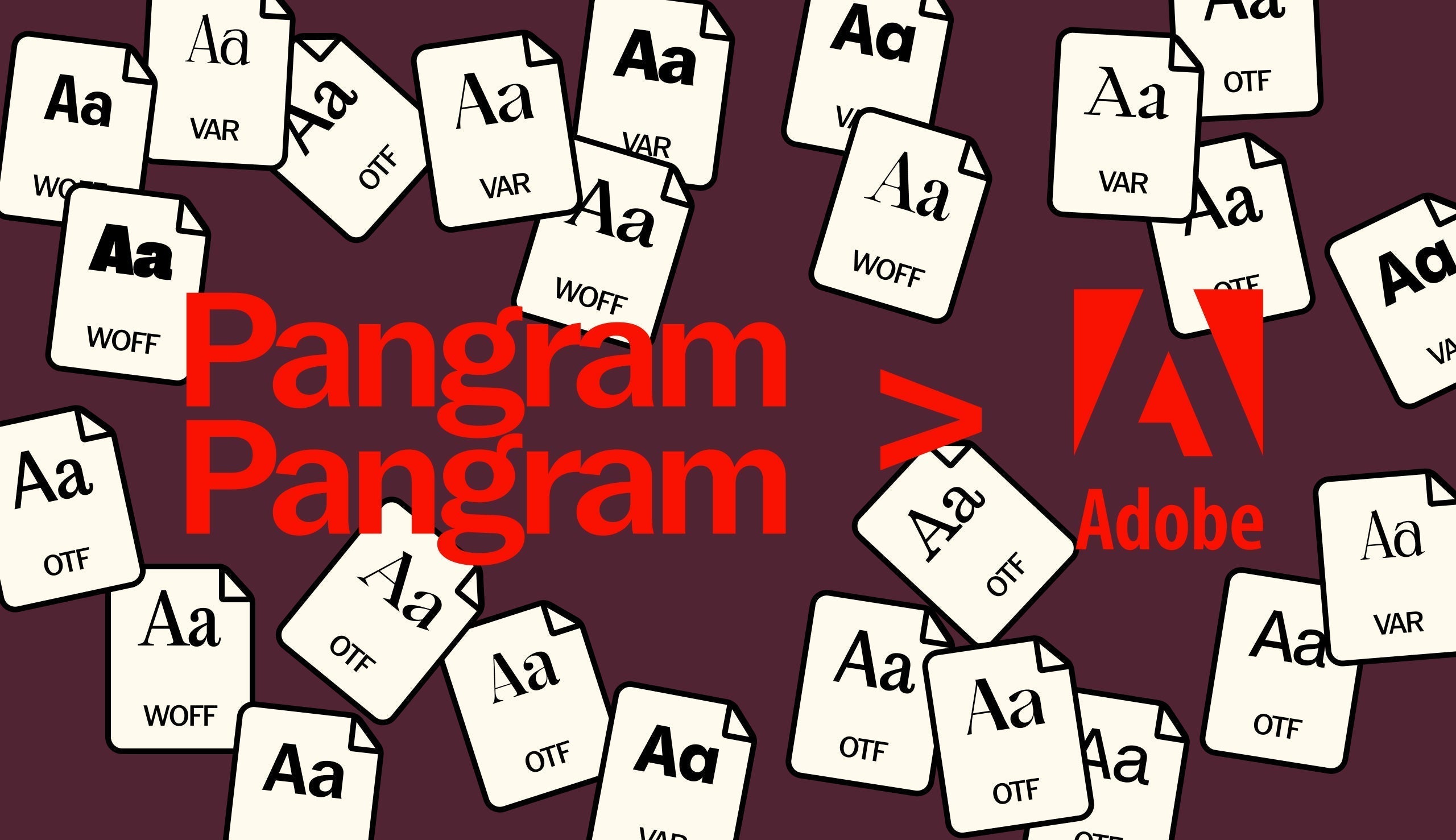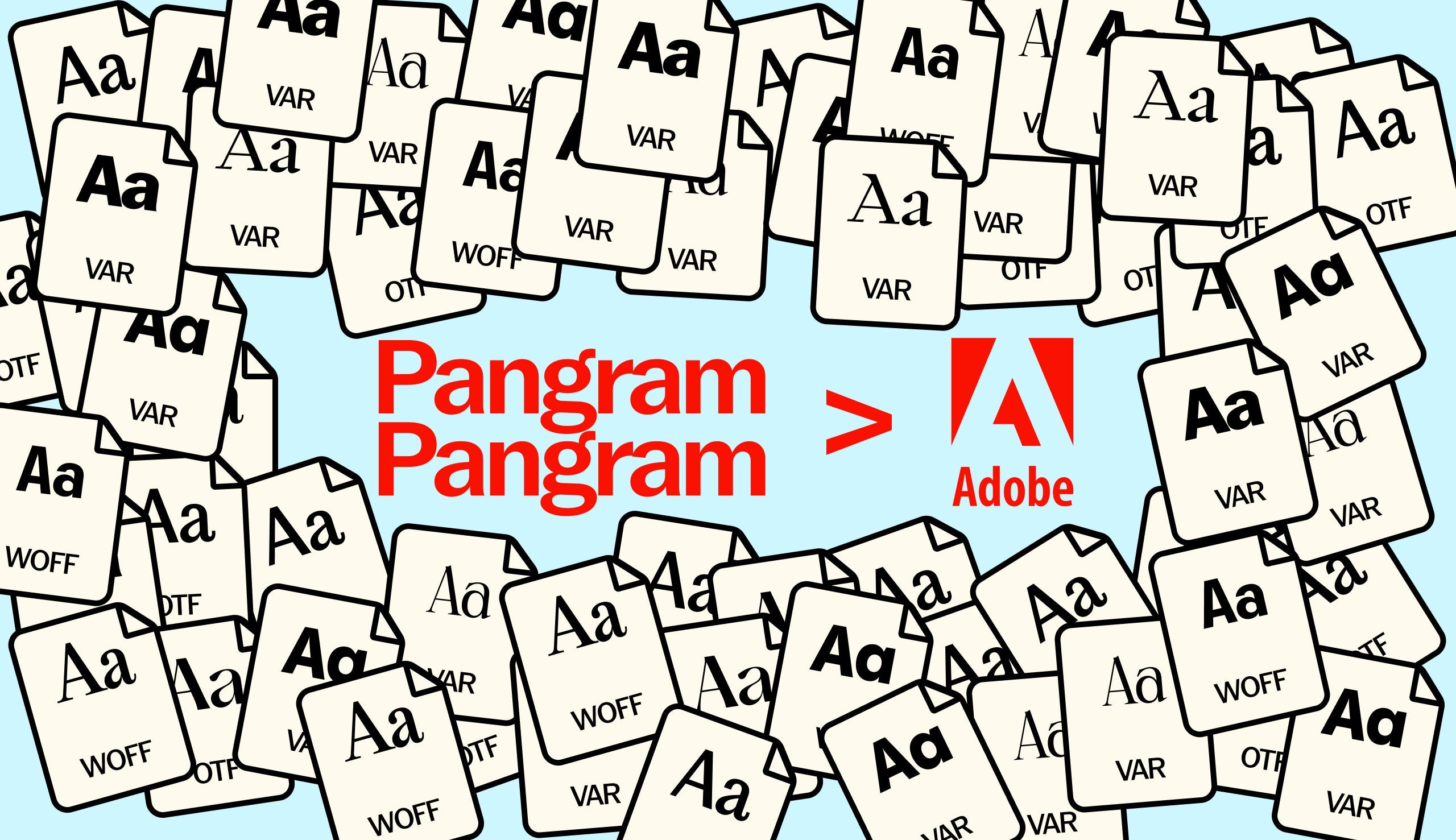Flying to new heights, Gatwick opens terminal 2.0
Released back in 2019, as Pangram Pangram’s first collaboration with type designer Valerio Monopoli (who knew where we’d be now, hey?!), Gatwick was a quick hit, with its outstandingly odd and oddly outstanding form and flair. Gatwick thrives on a small scale with sharp terminals and tapered stems, with ever more exuberant character being revealed as the scales increase. Now, back in the hands of Valerio, we’re excited to welcome the 2.0 update, building out its capacity through the introduction of two entirely new font families. Say hello to Gatwick Jumbo, Jet and Glider.
Bigger and better than ever, Gatwick 2.0 leans even more on its surprising calligraphic context, balancing a subtle retro charm and human imperfection with slick aeronautical engineering. Or, as Valerio suggests, the intersection of “elegance and funkiness.” Speaking more with the master behind the scenes, we dive/fly into the development behind Gatwick’s enormous update (and what the future may hold…)!
What was the motivation behind Gatwick’s big V2.0 update? How was the process for you?
When the original Gatwick family came out in 2018, it was not only my first collaboration with Pangram Pangram but also my first complete font. That means both my skills and the tools available at that time were less developed than now. Gatwick 2.0 is an attempt to improve the original font both technically and stylistically, while also expanding its expressive range with a new optical size axis.


What’re the key differences between the Jumbo, Jet and Glider families? (also, did you have fun with naming them? they’re so good, aha!)
The new families are placed on three different steps of the new axis. ‘Jumbo’ faithfully preserves the low contrast shapes of Gatwick 1.0, and it’s ideal for body text and subtitles. ‘Glider’ is at the opposite end of the axis and works as a delicate, high contrast counterpart to it. Lastly, ‘Jet’ sits right in the middle of the range, bridging the two extremes.
Unconventional family naming is something I have played a lot with in my latest releases, especially for OffType’s catalogue. There is a clear, albeit still arbitrary, terminology for weight, width and optical steps in type design, but every new family is an opportunity to redefine it according to the core concept. In this case, the names make reference to three kinds of aircraft – from heaviest to lightest. I hope these words will suggest what kind of composition the different families are meant for better than terms like ‘deck’ or ‘banner’, which only relate to size. Plus, they sound rad!
How did you approach balancing the contrasting characteristics within the Jumbo, Glider, and Jet families whilst maintaining cohesion between them all?
The underlying skeleton of the typeface remains unvaried throughout the optical axis, but many small adjustments were needed to turn the tapered stems into either serifs or fine lines, like in W or M. The greatest challenge was keeping the tapering centred and well interpolated in diagonal and curve segments, which required a methodical approach, based on the new segment components available in Glyphs 3 (something that was not there back when I designed Gatwick 1.0).


Could you walk us through the design process of adding tapered stems, sharp terminals, and Gatwick’s other super distinctive details?
There’s a reason why light tapered stems are not so common in the type world: they are tricky to design and trickier to interpolate, especially when contrast gets very thin, like in the ‘Glider’ family. Knowing how much work this update would have required if I had solely relied on manual work, I implemented curved segment components everywhere, which greatly simplified the process and guaranteed fail-proof interpolations in the variable exports.
What challenges did you face in enhancing the contrast for the Glider Family while preserving Gatwick’s legibility and base form?
In fonts like Gatwick , shapes hardly click together right away like in rationalist or modular ones. This means most connections had to be managed manually, and most shapes that look identical are actually tweaked separately, which ultimately gives the font a quite organic feeling. Another challenging part was picking the strokes that could be kept tapered and the ones that would need to be turned into straight lines. Not all terminals are created equal, and as usual calligraphy comes in very handy when facing these doubts, even in fonts that don’t seem to be rooted in it directly.


How does the Jet Family achieve a balance between the low-contrast Jumbo and the high-contrast Glider families?
It’s a quite literal in-between that has become my favourite family of the three because of its hybrid nature. Removing some contrast from Jumbo helped even out the horizontal stems all around, so in a way the Jet family represents the truest form of this typeface, lying at the intersection of elegance and funkiness.
Any future updates or expansions we can expect for Gatwick beyond its V2.0?
A possible V 3.0 would see the introduction of italics and Cyrillic script, which are already in the making!


Where would you love to see the newly expanded Gatwick used?
Any project where a bit of exuberance is not feared, but also some classy packaging or fashion product. A perfect example is Kourtney Kardashian’s wellness line ‘Lemme’, which already uses Gatwick as its logo face.
Gatwick and its fancy new update) is free to try now with trials starting at only $40!









